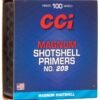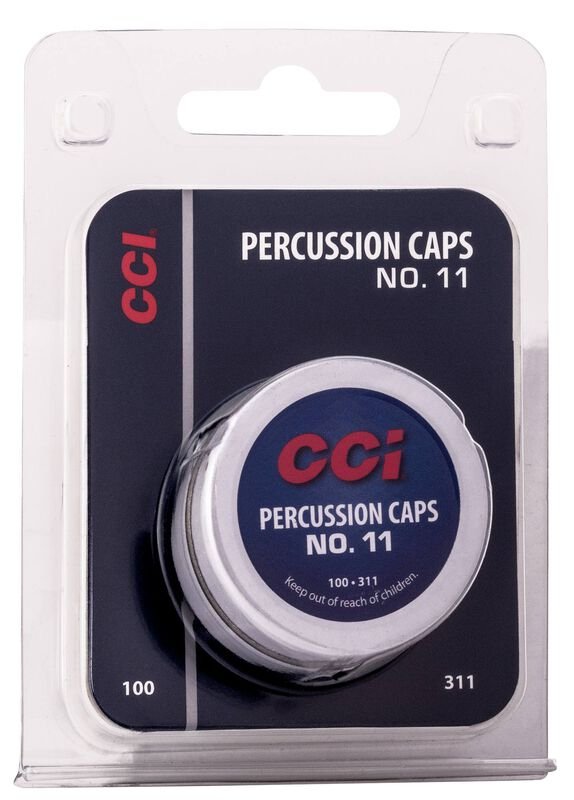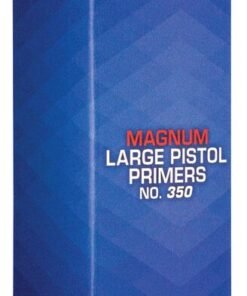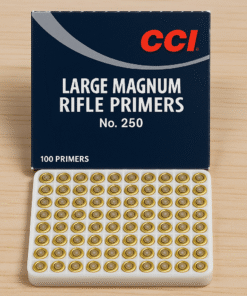Percussion Caps No. 11
$18.00 Original price was: $18.00.$15.00Current price is: $15.00.
- Bullet Style: Percussion Caps
- Package Quantity: 100
- Usage: Reloading
🧨 Percussion Caps No. 11 – Complete Guide
✅ What Are Percussion Caps?
Percussion caps are small, cylindrical metal cups filled with a shock-sensitive explosive compound (usually based on fulminate of mercury, lead styphnate, or modern equivalents). When struck by a hammer or firing pin, the compound ignites, sending a flame through a nipple (or flash hole) to ignite the main powder charge in a black powder firearm.
Percussion caps are used in:
-
Muzzleloaders (rifles, pistols)
-
Cap-and-ball revolvers
-
Some black powder shotguns
🔢 Percussion Cap No. 11 – Specifications:
| Feature | Details |
|---|---|
| Cap Size | No. 11 |
| Outer Diameter | Approx. 0.175–0.180 inches |
| Cup Material | Typically copper or brass |
| Ignition Compound | Modern non-corrosive (e.g., styphnate-based) |
| Usage | Mid-sized nipples (standard cap-and-ball revolvers & rifles) |
| Fit | Snug fit on most factory nipples; may need resizing for custom setups |
| Brands Available | CCI, Remington, RWS, Dynamit Nobel, Winchester |
| Packaging | Typically in tins of 100 or 1,000-count bulk boxes |
🔧 Typical Firearms Using No. 11 Caps:
-
.44/.36 caliber black powder revolvers (Colt and Remington replicas)
-
.50/.54 caliber muzzleloading rifles
-
Traditions, CVA, and Thompson Center caplock rifles
-
Some inline muzzleloaders (with modified nipples)
-
Replica pistols and rifles using standard percussion ignition systems
🔄 No. 10 vs. No. 11 – What’s the Difference?
| Feature | No. 10 Cap | No. 11 Cap |
|---|---|---|
| Diameter | ~0.166″ | ~0.175–0.180″ |
| Fit | Tighter | Looser |
| Use | Small-frame revolvers | Larger pistols & rifles |
| Brands Vary | Yes | Yes |
📝 Always test a few caps with your specific firearm. Some brands label No. 10 and No. 11 differently, and actual fit may vary.
⚙️ Function and Ignition Process:
-
Cap is placed on the nipple of a black powder firearm.
-
Hammer strikes the cap, crushing the compound inside.
-
The cap detonates, sending a flame through the nipple’s channel.
-
The flame ignites the main charge of black powder inside the barrel.
✅ Advantages of No. 11 Percussion Caps:
-
Widespread compatibility: Used in most percussion muzzleloaders
-
Moderate size: Easier to handle than smaller caps
-
Reliable ignition: Modern caps offer consistent performance
-
Less corrosion: Most are non-mercuric and non-corrosive
⚠️ Considerations and Safety Tips:
-
Storage: Keep in a cool, dry place away from static or spark sources.
-
Handling: Use capper tools for easier and safer loading.
-
Misfires: Ensure caps are seated fully and nipples are clean.
-
Replacement Nipples: Worn or oversized nipples can cause loose fit or misfires.
-
Use Only On Compatible Firearms: Not for modern smokeless powder guns.
🔍 Common Brands and Product Notes:
| Brand | Notes |
|---|---|
| CCI | Clean-burning, highly reliable, available in No. 11M (magnum) variant |
| Remington | Often considered “hotter”; slightly softer cup |
| RWS | Precision European brand, slightly tighter fit |
| Dynamit Nobel | High quality, consistent ignition |
| Winchester | Reliable, good fit for most factory nipples |
📦 No. 11 Magnum Percussion Caps:
Some brands (like CCI No. 11M) offer “Magnum” caps, which have:
-
Hotter flame
-
Better ignition for large powder charges or coarser granulated powders
-
Slightly more brisance (impact shock), which can help in cold or damp conditions
🔄 Troubleshooting Fit and Function:
-
Cap too loose?
-
Lightly pinch the cap to tighten
-
Use aftermarket nipples with slightly smaller diameters
-
Switch to a brand with a tighter fit (e.g., RWS)
-
-
Cap too tight?
-
Carefully seat with a capper
-
Avoid forcing – it can deform or detonate prematurely
-
Consider switching to No. 10 or a different nipple
-
🔥 In Summary – Why Use No. 11 Caps?
Percussion Cap No. 11 is:
-
The most commonly used cap size for black powder rifles and revolvers
-
Available from all major manufacturers
-
A versatile, reliable, and well-balanced choice for most black powder shooters
Be the first to review “Percussion Caps No. 11” Cancel reply
Related products
CCI Primers
CCI Primers
CCI Primers
CCI Primers
CCI Primers
CCI Primers
CCI Primers
CCI Primers
CCI Primers
CCI Primers
CCI Primers
CCI Primers
CCI Primers
CCI Primers
CCI Primers
CCI Primers
CCI Primers
CCI Primers



























Reviews
There are no reviews yet.